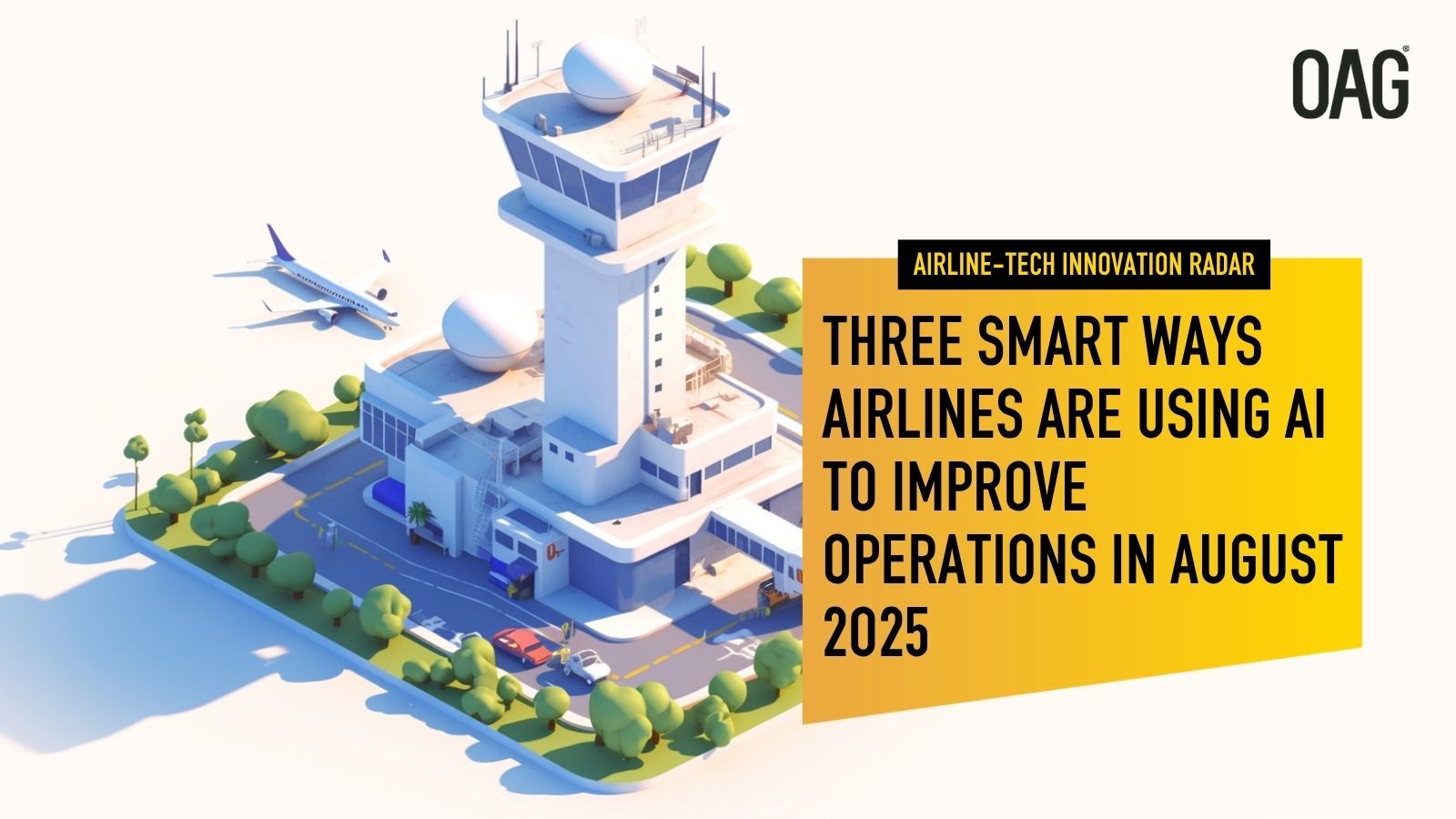Last month, we spotlighted how Big Tech is quietly reshaping the front end of the travel experience, embedding itself deeper into passenger touchpoints through platforms like Apple Wallet and ChatGPT. Now, the innovation spotlight has swung back to the airlines themselves.
In this month's edition of our Airline-Tech Innovation Radar, it’s the carriers, not the tech giants, driving the headlines, particularly when it comes to operational AI:
- Airlines are aggressively applying AI in more strategic, behind-the-scenes layers of their business.
- Many of these efforts mirror the themes we unpacked in our recent deep dive with Microsoft on AI and Airline Operations – proof that this space is heating up fast!
Let’s highlight three brand-new standout innovations where airlines take center stage, starting to build their own operational AI edge.
Key summary:
- American Airlines launches AI tool that lets passengers rebook themselves instantly when flights are delayed or canceled, with flight options tailored to each passenger’s situation.
- Korean Air rolls out generative AI tools for service agents to improve customer support.
- Lufthansa and Fraport use AI cameras to detect turnaround bottlenecks in real time and speed departures.
Innovation #1: AMERICAN AIRLINES Uses AI to Rebook Passengers and Hold Planes
American Airlines made one of the boldest digital transformation moves this year (so far).
The carrier announced a suite of AI-powered features aimed at minimizing disruption across the customer journey, including real-time app notifications, expanded biometric screening, and, most notably, a generative AI-based rebooking system.
The latter is the real standout here.
This system combines AI-assisted rebooking with AI-optimized aircraft hold decisions, so two layers of disruption management that work in sync to both solve and prevent one of the most frustrating traveler pain points: missed connections.
Here’s how it works:
- American Airlines now lets passengers rebook themselves instantly when flights are delayed or canceled, directly within the airline’s app or website. No need to queue for a gate agent or call a customer service line.
- Powered by generative AI, the tool surfaces alternate flight options tailored to each passenger’s situation, automating what used to be a stressful and resource-intensive process.
But the real innovation kicks in earlier, before a missed connection even happens.
At its core hubs Dallas Fort Worth (DFW) and Charlotte Douglas (CLT), American has deployed a proprietary “flight hold system” that uses AI to predict which outbound flights can be briefly delayed to wait for connecting passengers from delayed inbound flights.
- This kind of decision-making is often too complex for manual oversight or basic rules-based logic; it requires real-time analysis of network-wide schedules, aircraft rotations, crew duty limits, gate availability, and downstream delays - essentially a full-system simulation calculated in milliseconds.
- By combining prediction and prevention, AA is tackling disruptions on both ends: mitigating the chaos once it occurs, and reducing the chance it occurs at all.
Why does this innovation stand out?
- First, it's laser-focused on what matters most to travelers: staying on schedule. Flight disruptions are among the most frustrating parts of flying, especially during the packed summer season when weather volatility meets operational bottlenecks. Tools that reduce stress and increase transparency are a direct upgrade to the passenger experience.
- Second, this isn’t just a slick idea on paper. According to American, the new AI-powered rebooking tool has already helped more than 200,000 travelers during severe East Coast storms. Meanwhile, its flight-hold technology has reportedly saved “thousands of missed connections” – a vague claim, but one that signals real-world impact.
- Third, and most importantly, AA’s approach shows how AI can go beyond chatbots and optimization dashboards to power operational decisions with hardware implications. In that sense, the flight-hold AI system might be one of the most promising applications we’ve seen yet for how AI can augment airline operations at scale.

Innovation #2: Cloud Overhaul Lays AI Groundwork at Korean Air
Not all AI-driven transformation grabs major headlines, and that’s precisely why Korean Air’s latest tech upgrade deserves attention.
In July, the airline quietly completed a major behind-the-curtain overhaul of its contact center operations by migrating to a cloud-based infrastructure, replacing legacy PCs and operating systems with Google’s ChromeOS, and rolling out generative AI tools for service agents.
Here’s how it works:
At first glance, this might sound like a pure IT move. But it’s anything but. The airline’s shift to cloud-native tools has direct implications for customer experience, particularly when it comes to handling travel disruptions.
Rather than attempting to replace human support with bots, Korean Air is taking the hybrid path: equipping agents with the speed, security, and AI assistance they need to support travelers in high-stress moments.
- The company reports that agents now save 5–7 minutes during boot-up alone, while AI tools help them search internal knowledge bases, draft complex responses, and translate multilingual customer requests.
- That speed and intelligence at the first point of contact can mean the difference between a customer saving their trip or spiraling into hours of uncertainty and anxiety.
Why does this innovation stand out?
This overhaul is about setting the stage for what’s next. With its outdated legacy hardware and security patchwork now replaced by a centralized, secure, and nimble architecture, Korean Air is laying the critical groundwork for its next wave of innovation: more advanced AI integration across the traveler journey.
And while the tech stack may currently feature a prominent U.S. cloud vendor, that detail isn’t the headline. What truly matters is the strategic intent: shedding legacy dependencies to future-proof airline operations.
In the context of today’s generative AI race, only those carriers who modernize their infrastructure now will be in a position to test, implement, and scale AI features tomorrow.

Innovation #3: LUFTHANSA and Fraport Use AI Cameras to Speed Up Turnarounds
Most passengers never see what happens outside the window once they board. But behind the scenes, every second counts.
Aircraft turnaround time (the interval from arrival to departure) is one of the most critical and complex operations in aviation. Last week, Lufthansa announced that they have teamed up with airport operator Fraport to tackle this challenge with a homegrown AI solution called “seer”, developed by Lufthansa’s tech subsidiary, zeroG.
Here’s how it works:
- Using AI-powered cameras at Frankfurt Airport, seer continuously monitors ground operations, like baggage handling, catering, and refueling – all in real time.
- It then analyzes this data to detect bottlenecks and inefficiencies, offering actionable insights to optimize the turnaround process.
Why does this innovation stand out?
What sounds like a backstage improvement delivers front-stage benefits: better punctuality, fewer delays, and happier travelers.
We’ve covered this topic in detail before in our deep dive on aircraft turnaround operations.
- There, we showed how turnarounds often exceed the scheduled 60 to 90-minute window for most narrow-body aircraft on short-haul routes.
- Airlines tend to underestimate how long the process really takes.
- The result? Delays that compound throughout the day.
Optimizing these turnarounds doesn’t just save time, it reduces operational costs and cuts CO₂ emissions by minimizing unnecessary aircraft idling on the ground.
And there’s another layer to this innovation worth spotlighting: its collaborative model.
- Rather than buying a plug-and-play solution, Lufthansa developed seer in-house through its digital subsidiary, zeroG.
- And instead of treating ground operations as the airport’s responsibility, it partnered directly with Fraport.
- This kind of cross-stakeholder collaboration, powered by internal tech expertise, is exactly the kind of setup needed to solve the aviation industry’s most entrenched operational pain points.

Of course, these three examples are just the tip of the iceberg.
- We could have also spotlighted Air New Zealand’s move to roll out ChatGPT Enterprise access to 3,500 employees as part of a broader OpenAI partnership.
- Or Delta Air Lines’ rollout of AI-powered dynamic pricing that tries to pinpoint each traveler’s maximum willingness to pay (a highly controversial strategy).
- Or Air France-KLM’s newly launched generative AI factory, created in partnership with Accenture and Google Cloud, to fast-track AI adoption across the group.
The point is clear: AI has jumped to the top of every airline’s innovation agenda. And unlike in previous hype cycles, this time, carriers seem ready to move from buzzword bingo to business impact.




